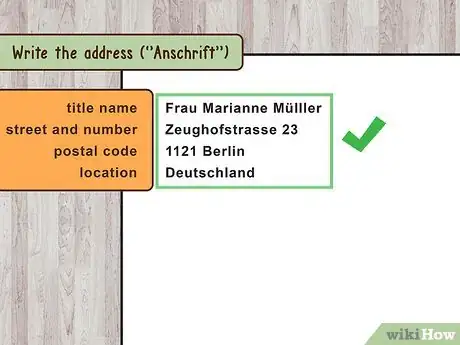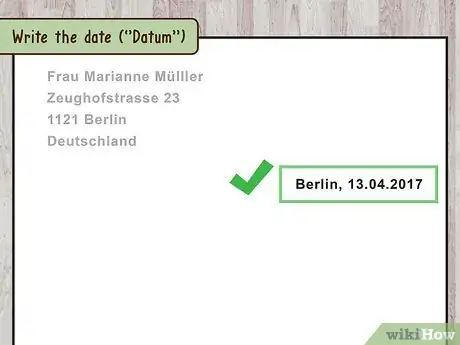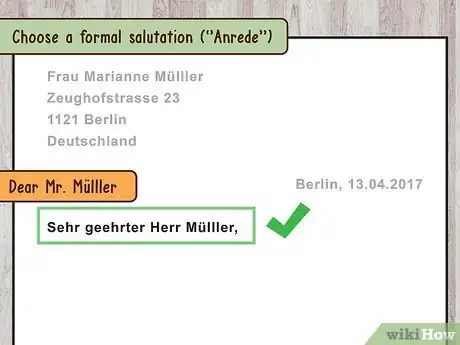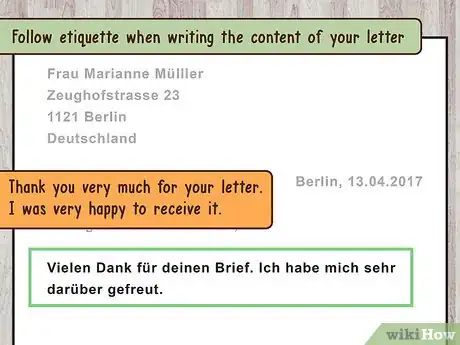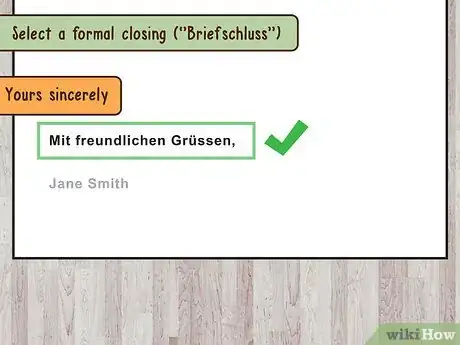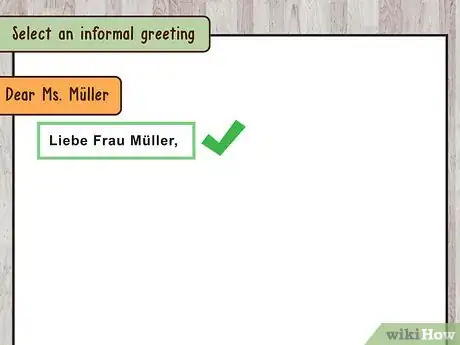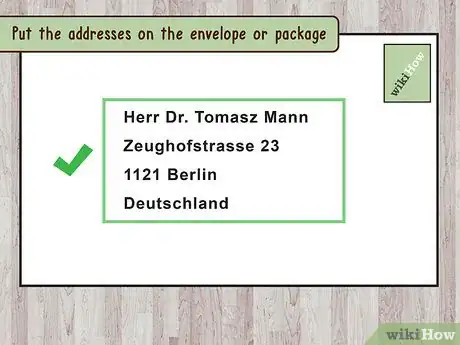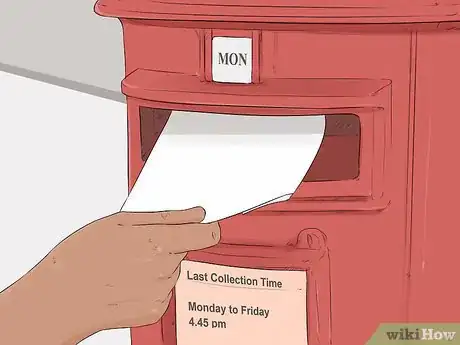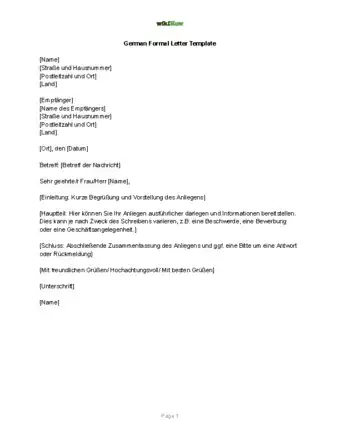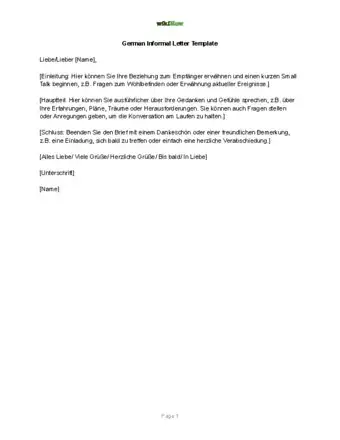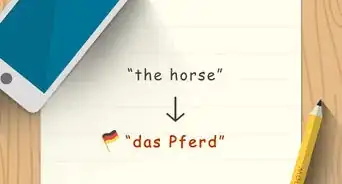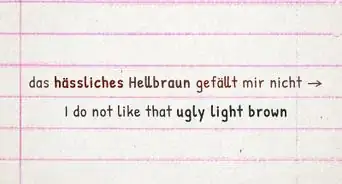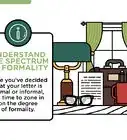This article was co-authored by wikiHow Staff. Our trained team of editors and researchers validate articles for accuracy and comprehensiveness. wikiHow's Content Management Team carefully monitors the work from our editorial staff to ensure that each article is backed by trusted research and meets our high quality standards.
This article has been viewed 156,676 times.
Learn more...
Whether you're doing business, writing to a friend, or practicing for a class or self-study, writing a letter in German requires a little attention to detail. Make sure to address your letter correctly and to use proper salutations and closings. Above all, follow the rules of etiquette that vary depending on whether your letter is informal or formal.
Steps
Corresponding Formally
-
1Write the address (‘’Anschrift’’). It’s only necessary to write an address on a letter if it is formal. Otherwise, you can just write the addresses on the envelope or package. The components of addresses in German come in a different order than in English: title, name, street and number, postal code (‘’Postleitzahl’’), and location. For example:
- Frau (Ms.--use "Herr" for Mr.) Marianne Mülller, Zeughofstrasse 23, 1121 Berlin, Deutschland
-
2Write the date (‘’Datum’’). This is usually placed in the top right corner of a document. There are multiple ways to write a date on a German letter, which may vary from the way it is written in English. You can also choose to write the place (‘’Ort’’) you are writing from along with the date. For example, all of the following are acceptable ways of writing “from Berlin on April 13, 2017.” Pay special attention to the placement of periods (don’t use dashes, slashes, or commas):
- 2017-04-13
- 13.04.2017
- 13. April 2017
- Berlin, 13.04.2017
- Berlin, den 13. April 2017
Advertisement -
3Choose a formal salutation (‘’Anrede’’). Letters in German should always begin with a short greeting addressed to the reader of the letter. For formal correspondence, there are a number of acceptable salutations. If you are corresponding with a professional (such as a doctor or official), include their title. Make sure to pay attention to differences in spelling depending on whether you are writing to a man, woman, or both:
- Sehr geehrte Damen und Herren (Dear Sir or Madam)
- Sehr geehrte Damen (Dear Madam)
- Sehr geehrte Herren (Gentlemen)
- Sehr geehrte Frau Müller (Dear Ms. Müller)
- Sehr geehrter Herr Mülller (Dear Mr. Mülller)
- Sehr geehrte Frau Bundeskanzlerin (Dear Ms. Chancellor)
- Sehr geehrter Herr Professor Müller (Dear Professor Müller)
- Sehr geehrte Frau Dr. Mann, sehr geehrter Herr Mann (Dear Dr. Mann, dear Mr. Mann)
-
4Follow etiquette when writing the content of your letter. For formal correspondence in German, you can be direct about the purpose of your writing. However, it is a still a good idea to structure your letter carefully, and to show courtesy.
- Start the body of your letter with a brief introduction (identify yourself, greet the addressee, briefly explain the purpose of your letter). Unlike in English, you do not capitalize the first word in the body of your letter.
- Follow this by writing in detail about the purpose of your letter. Be clear about what you are requesting, explaining, or inquiring about (for example, registering a complaint or asking about a business opportunity).
- End the body of your letter with a short closing that summarizes the purpose of your letter, explains if/how you would like the addressee to follow up, and thanks them for their time.
-
5Select a formal closing (‘’Briefschluss’’). The closing of your letter should be courteous and respectful. Like the salutation, it can take one of several forms. Pay special attention to the spelling, since closings that sound very similar in English will be written in distinctly different ways in German. Potential closings (and their approximate English equivalents) include:
- Mit freundlichen Grüssen (Yours sincerely)
- Mit freundlichem Gruss (Sincerely)
- Freundliche Grüsse (Kind regards)
- Mit den besten Grüsssen (With best regards)
- Beste Grüsse aus Berlin (Best regards from Berlin)
- Herzliche Grüsse (Warm greetings)
Writing an Informal Letter
-
1Select an informal greeting. When writing an informal letter in German, as in English, you have more freedom in terms of starting your letter. It’s not necessary to write the date or address, though you can if you want. Give your letter an informal salutation that suits who you are writing to. Pay special attention to the spelling. For example, write “Liebe” (“Dear”) if you are writing to a woman, but “Lieber” (“Dear”) if you are writing to a man. Try one of these greetings:[1]
- Guten Tag, Frau Müller (Good day, Ms. Müller)
- Liebe Frau Müller (Dear Ms. Müller)
- Lieber Heinrich (Dear Heinrich)
- Hallo, Andreas (Hi Andreas)
- Mein lieber Schatz (My dear honey)
- Hallo mein Liebling (Hello my darling)
- Hallo meine Süße (Hello sweetie - female)
- Hallo mein Süßer (Hello sweetie - male)
-
2Write the body of your letter. Since you are writing an informal letter, you have plenty of freedom for choosing what to say and how to structure it. In general, try to keep your ideas grouped together, and separate paragraphs with line breaks to make your letter easy to read.
- Remember that you do not need to capitalize the first word of the body of your letter.
-
3Close your letter informally. Even for letters to friends or family, it’s courteous to include an clear closing in your letter. You can be more casual or even intimate, depending on who you are writing to. Try one of these common closings:[2]
- Herzlichst (Cordially)
- Viele Grüße (Lots of regards)
- Liebe Grüße (Lots of love)
- Alles Liebe (Lots of love)
- Dein (Yours - male)
- Deine (Yours - female)
- In Liebe (With love - for romantic relationships)
Sending Your Letter
-
1Format the addresses. If you are sending a physical letter, you will need the name of the person, business, or organization you are writing to (and their title, if applicable), their street address, the postal code, and location. You should also include the destination country, especially if you are writing from overseas. Write the information in the proper order, according to this model:[3]
- Herr Dr. Tomasz Mann, Zeughofstrasse 23, 1121 Berlin, Deutschland
-
2Put the addresses on the envelope or package. Make sure to put your (the sender’s) address at the top left corner, formatted in the same way as the address of who you are writing to. Put the recipient’s address on the lower right.[4]
-
3Mail your letter. If you are sending a letter within or from Germany, you can contact Deutsche Post, visit their website, or stop by one of its offices for details about how to purchase postage and send your letter. If you are writing to Germany or another location, contact your local post office for information about how to deliver the letter. You may also have private shipping options from carriers like FedEx, DHL, and UPS.[5]
-
4Follow standard letter-writing conventions when sending an email. For the most part, the guidelines for writing a letter in German apply when sending an email or other electronic correspondence. Above all, pay attention to the distinctions between formal and informal writing. Even though email is instantaneous, it still pays to show courtesy and respect, especially when writing to people you don’t know.
Formal and Informal German Letter Templates
Community Q&A
-
QuestionWhat's an example of a greeting in a letter?
 Community AnswerThe most common informal greeting in a letter or email is "Lieber" (for a male person) / "Liebe" (for a female person). If you'd like to be more formal you normally use "Sehr geehrter" (for a male person) / "Sehr geehrte" (for a female person).
Community AnswerThe most common informal greeting in a letter or email is "Lieber" (for a male person) / "Liebe" (for a female person). If you'd like to be more formal you normally use "Sehr geehrter" (for a male person) / "Sehr geehrte" (for a female person). -
QuestionHow do I say "my German language skills are limited"?
 Community Answer"Ich spreche leider nicht gut Deutsch." Try getting the pronunciation right so someone can actually understand you, and also learn more German so this is not a longer lasting problem.
Community Answer"Ich spreche leider nicht gut Deutsch." Try getting the pronunciation right so someone can actually understand you, and also learn more German so this is not a longer lasting problem. -
QuestionHow do you write a letter to someone who only knows German if you don't know it?
 KevaughnCommunity AnswerThere is no way one can do something without actually knowing how to do it. It is good to do your own research and learn German in order to write to someone who only speaks that language. If not, you could utilize a translation app such as Google Translate or another you may prefer to use instead.
KevaughnCommunity AnswerThere is no way one can do something without actually knowing how to do it. It is good to do your own research and learn German in order to write to someone who only speaks that language. If not, you could utilize a translation app such as Google Translate or another you may prefer to use instead.
References
- ↑ http://blogs.transparent.com/german/writing-a-letter-in-german-informal-letters/
- ↑ http://blogs.transparent.com/german/writing-a-letter-in-german-informal-letters/
- ↑ https://www.deutschepost.de/de/b/briefvorlagen/kuendigung.html
- ↑ https://www.deutschepost.de/de/b/briefvorlagen/kuendigung.html
- ↑ https://www.deutschepost.de/de/b/briefe-in-deutschland.html
About This Article
If you’re writing a letter in German, the style requirements will differ depending on whether your letter is formal or informal. For a formal letter, write the address in the top left-hand corner and the date in the top right. For example, write “Frau Marianne Muller, Zeughofstrasse 23, 1121, Berlin.” You should begin your letter with a formal greeting, such as “Sehr geehrte Damen und Herren,” which means “Dear sir or madam.” In the body of your letter, introduce yourself in a brief paragraph and explain the purpose of the letter. Close with a formal salutation, such as “Mit freundlichen Grüßen,” which means “Yours sincerely.” If your letter is informal, you can just write the address on the envelope. Try using an informal greeting, like “Liebe Heinrich,” which means “Dear Heinrich.” To close your letter less formally, try something like “Liebe Grüße, which means “Lots of love.” For tips on how to send your letter, keep reading!
